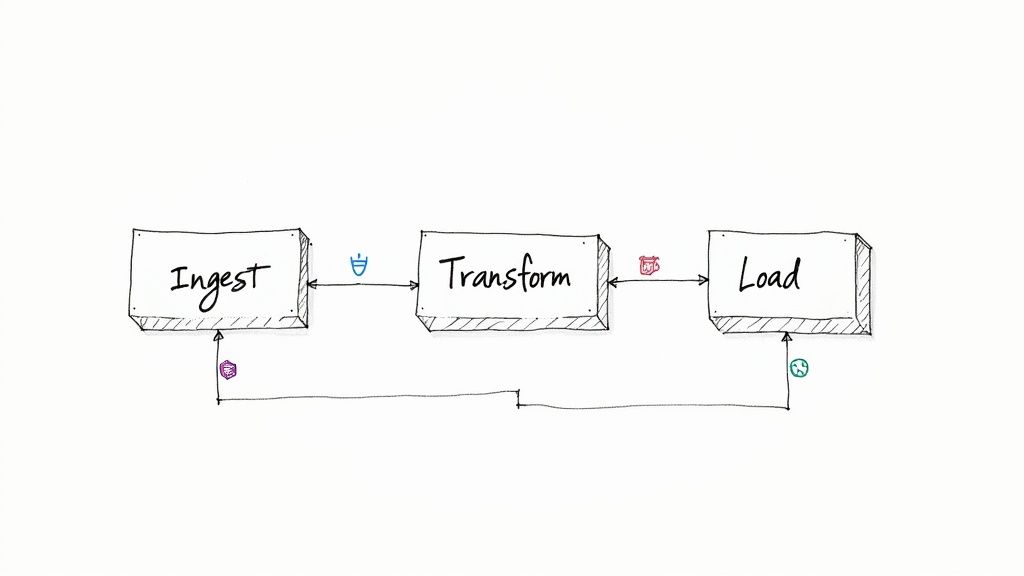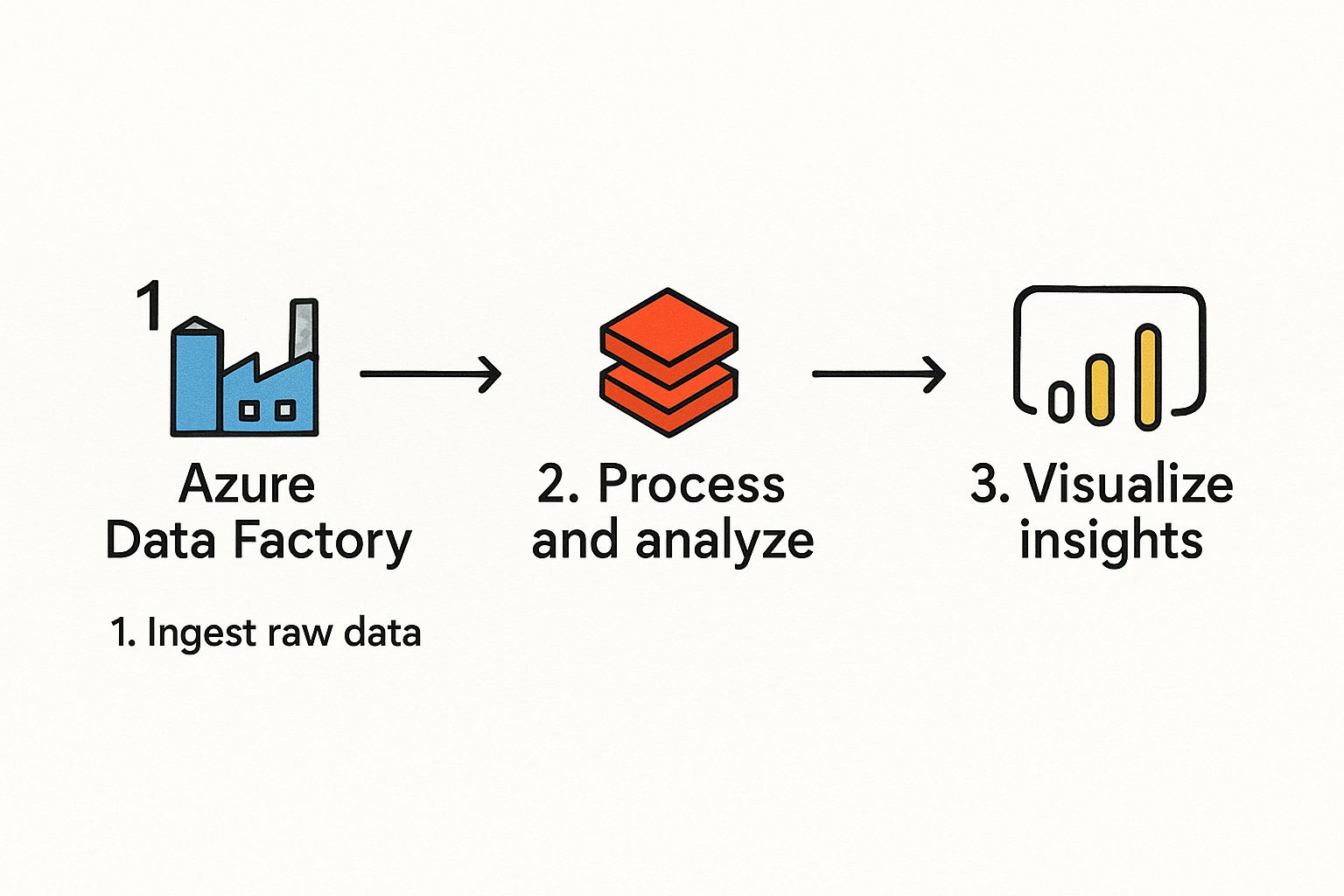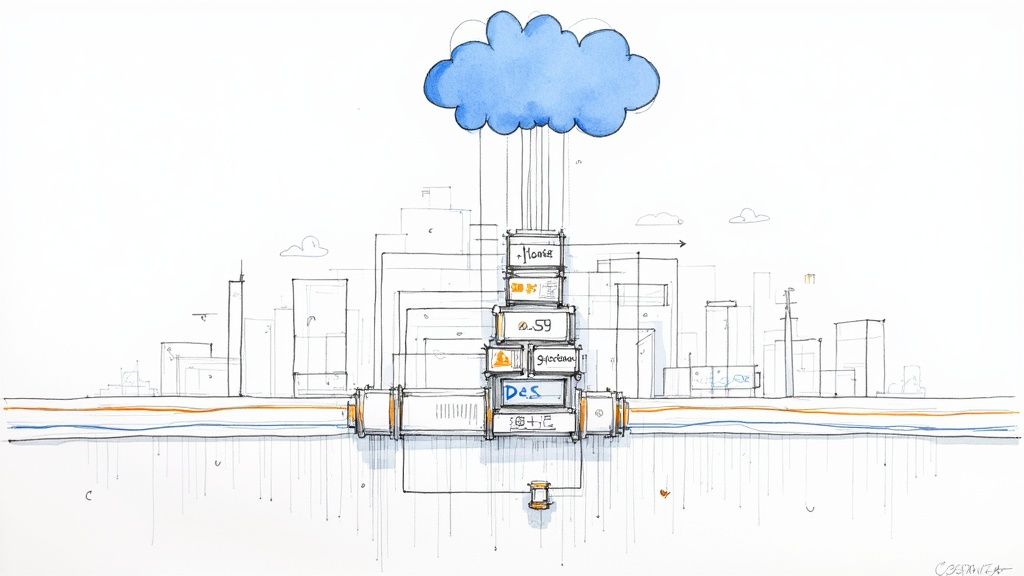An Azure data engineering course is your launchpad for a career spent designing and managing the massive data systems that fuel today's business intelligence and machine learning. In essence, you learn how to build powerful data pipelines on Microsoft's cloud platform, transforming floods of raw information into a company's most valuable asset.
Why Start an Azure Data Engineering Journey
Let's face it, companies are practically drowning in data. But on its own, raw data is a bit like crude oil—plentiful, messy, and not very useful. This is where an Azure Data Engineer comes in. You’re the one who builds the refinery.
Your job is to design the systems that collect, clean, and process all that raw data into high-grade fuel ready for analytics and AI. It's less about analyzing the data yourself and more about making sure it gets to the data scientists and analysts cleanly and efficiently.
Think of yourself as the architect of a city's water supply. You don't dictate how each household uses water, but you're responsible for the entire complex network—the reservoirs, purification plants, and pipelines—that ensures clean, reliable water is always on tap. In the same way, you ensure an organization's data is accessible, trustworthy, and ready for action.
The Demand and Value of an Azure Data Engineer
This career path isn't just technically fascinating; it's also incredibly valuable and in high demand. As more companies move their operations to the cloud, they desperately need skilled professionals who can manage data at an enormous scale.
The numbers don't lie. The U.S. Bureau of Labor Statistics projects that employment for data professionals will skyrocket by 36% between 2021 and 2031—a growth rate that dwarfs the average for other jobs. This surge is directly tied to the explosion of cloud technologies and big data analytics.
Consider that over 95% of Fortune 500 companies now run critical workloads on Microsoft Azure. That creates a constant, pressing need for certified experts. An Azure data engineering course isn't just about learning a new skill; it's a strategic investment in a stable and rewarding career. You can explore more on the value of Azure certifications to see just how well they align with what employers are looking for.
To quickly summarize what this career path looks like, here’s a high-level overview.
Azure Data Engineer Role at a Glance
This table breaks down the core aspects of the Azure Data Engineer role, from market demand to earning potential.
| Aspect | Details |
|---|---|
| Market Demand | Extremely high, driven by enterprise cloud adoption and the need for data-driven insights. |
| Core Duties | Designing data storage solutions, building data processing pipelines, and ensuring data security and compliance. |
| Salary Potential | Highly competitive, often exceeding six figures with experience and certification. |
Ultimately, a well-structured Azure data engineering course gives you the knowledge and hands-on skills to step into this role with confidence. You'll be ready to manage the powerful tools that modern businesses depend on to stay competitive.
Core Skills You'll Master in an Azure Data Engineering Course

When you jump into a quality Azure data engineering course, you're doing more than just memorizing a list of cloud services. You're learning a craft—the art of building and managing the digital plumbing that transforms raw, messy data into genuine business intelligence. A good curriculum is built around the real-world data lifecycle, always focusing on why you use a tool, not just what it does.
Think of it like this: raw data floods in from all over the place, like a bunch of rivers merging. Some are clean, some are muddy with debris, and they all flow at different speeds. Your job as a data engineer is to build the dams, purification plants, and aqueducts to manage this flow, making it clean, useful, and ready for consumption.
A solid course will equip you to master the specific Azure tools that make this happen. You'll walk away with a practical, hands-on understanding of how each piece fits into the larger puzzle, fully preparing you for the challenges you'll face on day one of the job.
Data Ingestion and Orchestration with Azure Data Factory
The first major skill you'll pick up is data orchestration. Before you can analyze or even look at data, you have to get it from where it lives. This is where Azure Data Factory (ADF) shines, acting as your mission control for all data movement.
Imagine you're running a global logistics company. Your entire business revolves around picking up packages (data) from countless locations (databases, APIs, log files), moving them efficiently, and maybe even repackaging them mid-journey. ADF is the software that lets you design, schedule, and automate these "shipping routes," which we call pipelines.
In your course, you'll get your hands dirty learning to:
- Build Data Pipelines: Create automated workflows that pull and push data from hundreds of potential sources.
- Handle Diverse Data Types: Work confidently with structured data from SQL databases and unstructured data from social media feeds.
- Monitor and Manage Workflows: Keep a close eye on your pipelines to ensure they run like clockwork and learn how to troubleshoot when they don't.
This is a non-negotiable, foundational skill. After all, if you can't get the data, you can't do anything else with it.
Key Insight: Mastering Azure Data Factory is like becoming an expert in supply chain management, but for data. You learn to control the flow, timing, and transformation of information—the critical first step in every single data project.
Storing Data at Scale with Azure Data Lake Storage
Once the data arrives, it needs a home. Any top-tier Azure data engineering course will spend significant time on Azure Data Lake Storage (ADLS). This isn't just another folder on a server; it's a massive, highly cost-effective repository built to hold colossal amounts of data in its original, raw format.
Picture a vast, impeccably organized warehouse where you can store anything—from tiny packets of sensor data to huge video files—without having to sort and label them first. This flexibility is a game-changer for modern analytics and machine learning. You'll also learn the practical side of managing this storage, like setting up secure access controls and logical folder structures. Plus, you’ll discover how to automate many of these tasks; our guide to the Azure PowerShell module offers more context on how scripting ties into managing the Azure environment.
Processing and Transforming Data
With your data collected and stored, it's time for the real work: processing. This is the heavy-lifting phase where raw information gets turned into something valuable. You’ll learn to wield two of Azure's most powerful services: Azure Databricks and Azure Synapse Analytics.
- Azure Databricks: Think of this as your high-performance workshop. Built on Apache Spark, Databricks is an analytics platform supercharged for the Azure cloud. It’s the king of large-scale data processing and collaborative machine learning. You’ll be writing code in notebooks to clean, reshape, and enrich your data at blistering speeds.
- Azure Synapse Analytics: This is the central command center where everything comes together. Synapse brilliantly merges big data analytics with traditional data warehousing, letting you query enormous datasets with familiar SQL. It closes the gap between raw data lakes and structured warehouses, giving you a unified service for your entire analytics pipeline.
To validate these crucial skills, Microsoft has laid out a clear certification path. Before tackling the core DP-203 exam, many professionals start with foundational knowledge to get their bearings.
Here’s a quick look at how the key certifications compare:
Comparison of Key Azure Data Certifications
| Certification Exam | Primary Focus | Ideal Candidate |
|---|---|---|
| AZ-900: Azure Fundamentals | Broad overview of core Azure concepts, cloud principles, and foundational services. | Anyone new to the cloud or Azure. Not data-specific, but an excellent starting point. |
| DP-900: Azure Data Fundamentals | Introduction to core data concepts and how they are implemented using Azure data services. | Aspiring data professionals, business stakeholders, or anyone needing to understand the Azure data landscape. |
| DP-203: Data Engineering on Azure | In-depth design and implementation of data storage, processing, security, and monitoring solutions. | The core certification for individuals pursuing a career as an Azure Data Engineer. |
This structured approach, moving from broad fundamentals to specialized skills, ensures you build a comprehensive and practical understanding. As you follow the Azure Data Engineer certification roadmap, you'll find that each step logically builds on the last, preparing you thoroughly for the demands of a real-world data engineering role.
How Azure Certifications Are Evolving
The world of cloud technology moves at a breakneck pace, and the credentials proving your skills have to keep up. If you're looking into an Azure data engineering course, it's absolutely vital to understand how Microsoft's certification landscape is shifting to reflect where data platforms are headed.
This isn't just about tweaking a few exam questions. It's a major strategic shift driven by how modern data problems are actually being solved. Microsoft is pushing towards more integrated, all-in-one platforms, and its certifications are changing to match. Staying on top of these changes is the difference between training for the jobs of tomorrow and the jobs of yesterday.
The Retirement of the DP-203 Certification
For a long time, the Microsoft Certified: Azure Data Engineer Associate, earned by passing the DP-203 exam, was the go-to credential. That's no longer the case.
As of March 31, 2025, the DP-203 certification has been officially retired. This move signals a huge pivot in Microsoft's strategy. They are moving away from a collection of separate data tools and towards a unified analytics platform called Microsoft Fabric. You can read Microsoft's official statement on the certification changes to get the full story.
This screenshot from a Microsoft community forum addresses the transition directly.

The message is clear: while your existing DP-203 certification will still show up on your transcript, the path for new data engineers is now completely different.
The Rise of Microsoft Fabric and the New DP-700 Exam
So, what does this retirement mean for you? It means it’s time to redirect your focus toward the future. Microsoft's recommended replacement is the Fabric Data Engineer Associate certification, which you earn by passing the new DP-700 exam.
The Big Idea: Microsoft Fabric is an end-to-end analytics solution. It brings everything from data movement and data lakes to data science and business intelligence into a single, unified environment. This new certification is built to validate your skills on this cohesive platform, reflecting a more modern, holistic approach to data engineering.
Instead of needing to master Azure Data Factory, Synapse Analytics, and Databricks as separate tools, the DP-700 exam tests how you use their combined power within the Fabric ecosystem. This is a game-changer for anyone choosing an Azure data engineering course.
Here’s what this means for your learning journey:
- Updated Curriculum: Any quality course you consider must be built around the DP-700 exam objectives and the Microsoft Fabric platform. An old course still focused on DP-203 is teaching you for a certification that’s already obsolete.
- A Focus on Integration: The new way of thinking is less about individual tools and more about how they seamlessly connect. You’ll be building solutions in a single interface—a massive departure from the old, component-based model.
- Future-Proofing Your Skills: By preparing for the DP-700, you are aligning your expertise with Microsoft's strategic vision for data and AI. This makes your skills far more relevant and valuable to employers who are quickly moving to Fabric.
This whole situation perfectly illustrates why you have to keep an eye on certification paths. For more general advice, our article on how to get Microsoft certified offers a broader look at navigating the process. Ultimately, choosing a course that embraces this industry-wide shift is the smartest investment you can make in your data engineering career.
Your Practical Learning Plan from Zero to Pro
Starting a new technical journey can feel like trying to drink from a firehose. I get it. But with a solid plan, you can turn that overwhelming flood of information into a series of manageable steps. Whether you're coming in cold or shifting from another IT field, a good roadmap is what separates ambition from actual achievement.
The goal here isn't just to passively watch videos. It's about building real, marketable skills. A well-thought-out plan provides structure, lets you see your progress, and makes sure you don't accidentally skip over the stuff that really matters on the job.
Building Your Foundation First
Before you even think about complex data pipelines in Azure, you have to get the fundamentals down. Jumping straight into a specialized course without this groundwork is like trying to build a house on a shaky foundation—it’s just not going to work. You'll end up frustrated and wasting time.
I always tell people to get comfortable with these three core areas first:
- SQL (Structured Query Language): This is the bread and butter of data. You'll use it every single day to pull, change, and manage data. Strong SQL skills are absolutely non-negotiable.
- Python: As the go-to language for automating tasks and wrangling data, Python is a must. You don't need to be a software developer, but you should be able to write basic scripts and know your way around libraries like Pandas for data analysis.
- Cloud Computing Basics: You don't need to be a cloud architect, but understanding the difference between IaaS, PaaS, and SaaS is crucial. Get a handle on the basic concepts of storage, compute, and networking in a cloud environment.
Once you have these prerequisites locked in, you'll be able to absorb what you learn in an Azure data engineering course so much faster.
A Sample 90-Day Learning Roadmap
With a solid foundation in place, you’re ready to dive in. I find a 90-day plan hits the sweet spot—it's intense enough to make real progress but sustainable enough that you won't burn out. Think of this as a template to guide you from feeling like a novice to being truly job-ready.
Month 1 (Weeks 1-4): Foundational Azure and Data Concepts
The first month is all about getting your bearings. You'll learn your way around the Azure portal and get to know the core services that data engineers use every day.
- Week 1: Start with Azure fundamentals. Don't skip this! Focus on how Azure organizes resources, manages access, and how to navigate the portal without getting lost.
- Week 2: Crack open your Azure data engineering course material. Begin with data storage—specifically, Azure Blob Storage and Azure Data Lake Storage Gen2. Understand why you'd use one over the other.
- Week 3: Time to talk about processing that data. Get a solid conceptual understanding of the two heavyweights: Azure Databricks and Azure Synapse Analytics.
- Week 4: Let's move some data around. Focus on Azure Data Factory. Your goal is to build your first simple pipeline, maybe just copying a file from one storage account to another.
This is the classic data engineering flow you'll be mastering—getting raw data, transforming it into something useful, and serving it up for analysis.

This visual really captures the essence of what we do: ingest, process, and deliver.
Month 2 (Weeks 5-8): Deep Dive and Hands-On Labs
Okay, the theory is important, but this is where the magic happens. The second month is all about getting your hands dirty. Real skill is built by doing, not just watching.
My Two Cents: This is the point where you must go off-script. Following tutorials is great, but now is the time to start a small personal project. Grab a public dataset, ingest it, clean it up with a Databricks notebook, and land it in a SQL table. This experience is priceless.
- Weeks 5-6: Go deep on Azure Databricks. Get comfortable with Spark, DataFrames, and writing data transformation notebooks that actually work.
- Weeks 7-8: Shift your focus to Azure Synapse Analytics. Learn what a modern data warehouse really is, how to integrate Spark pools, and how to run SQL queries over massive datasets.
Month 3 (Weeks 9-12): Advanced Topics and Exam Prep
The home stretch! This last month is about filling in the gaps with more advanced concepts and getting ready to prove your skills with a certification. Keep in mind the certification path has now shifted to focus on the DP-700 exam and Microsoft Fabric.
- Weeks 9-10: Tackle topics like security, monitoring, and performance tuning. Learn how to implement role-based access control (RBAC) to keep data secure and set up alerts so you know when a pipeline fails.
- Weeks 11-12: It’s all about exam prep. Hammer practice tests, go back and review the areas where you feel weakest, and bring all your knowledge together.
Following a structured plan like this takes the vague goal of "becoming a data engineer" and turns it into a clear, step-by-step process that will set you on a direct path to success.
How to Choose the Right Azure Data Engineering Course
So, you have a solid learning plan. That's a huge first step. Now comes the tricky part: picking the right Azure data engineering course to bring that plan to life. The market is absolutely packed with options, but frankly, they aren't all created equal. Choosing poorly can be a costly mistake, not just in money, but in time spent learning outdated material.
Think of it like hiring a personal trainer for a marathon. You wouldn't pick someone whose methods are stuck in the 1990s. You need a program that’s current, practical, and directly tied to what employers are looking for right now.
Evaluate the Curriculum and Instructors
The very first thing you need to scrutinize is the course curriculum. Let's be blunt: the DP-203 exam is retired. Any course still built around it is obsolete. To be worth your time, the curriculum must be designed around Microsoft Fabric and the new DP-700 certification exam.
Next, take a hard look at who’s actually teaching. Are the instructors academics who only know the theory, or are they seasoned professionals who have spent years in the trenches building real-world data solutions? The best guides are always the ones with dirt under their fingernails. They bring practical wisdom and stories from the field that you’ll never find in a textbook.
A great instructor doesn't just show you how to do something; they explain why it's done that way. That's the difference between just knowing a tool and truly understanding the craft.
Prioritize Hands-On Learning and Community
Let’s be real: you can't learn data engineering by just watching videos. True skill is forged in practice. A course that's nothing more than a series of lectures is selling you short. You absolutely need an Azure data engineering course that pushes you into hands-on labs and real projects.
Key Takeaway: The real learning begins when you roll up your sleeves, break things, figure out how to fix them, and build something from the ground up. Look for courses that give you access to an actual Azure environment and well-designed labs that force you to apply what you've just learned.
Another game-changer is a supportive community. It's an asset that's easy to overlook but incredibly valuable. Having a network of fellow learners to ask questions, share frustrations, and celebrate wins with can be a lifeline, especially when you’re wrestling with a tough concept late at night.
Compare Learning Formats
People learn differently, and thankfully, courses come in a few different flavors. Knowing the pros and cons of each format will help you find the perfect match for your schedule, budget, and learning style.
| Course Format | Pros | Cons |
|---|---|---|
| Self-Paced Videos | Incredibly flexible, usually more affordable, and you set the pace. | Demands serious self-discipline, no direct instructor feedback, can feel isolating. |
| Live Virtual Classes | A set schedule keeps you on track, direct Q&A with instructors, and you learn with peers. | Less flexible, often more expensive, and the pace might be too fast or too slow for you. |
| Bootcamps | Deeply immersive and fast-paced, designed to accelerate learning, often includes strong career support. | A major investment of time and money, and the intensity can be overwhelming for some. |
Ultimately, the best Azure data engineering course is the one that fits your unique situation. If you carefully check that the curriculum is fresh, the instructors have real-world chops, there are plenty of hands-on labs, and the format works for you, you can feel confident you're making an investment that will pay off for years to come.
Common Questions About Azure Data Engineering

Jumping into any new field brings up a ton of questions. It's only natural. When you’re looking at an Azure data engineering course, you're probably wondering what the job is really like, how tough the exams are, and what it all means for your career. Let's break down some of the most common questions I hear to give you a clearer picture of the path ahead.
How Much Coding Do I Really Need?
This is a big one. Do you need to be a Python wizard? Not exactly, but you absolutely need a solid foundation. You'll be using Python constantly for scripting data transformations, automating jobs in Azure Databricks, and wrangling data with libraries like Pandas. It’s your go-to tool for getting data into shape.
Are the Certification Exams Hard?
The short answer? Yes, they're challenging. But they are completely passable with the right preparation. These exams aren't about memorizing trivia; they're designed to prove you can solve real-world problems using Azure. They test your ability to think like an engineer and implement data solutions from the ground up.
Key Insight: The trick to passing these exams isn't about cramming facts. It's about getting your hands dirty and building real experience. This is precisely why a course with excellent, hands-on labs is non-negotiable for success.
What Does a Day in the Life Look Like?
Your day-to-day work will have a lot of variety, but it usually centers on a few key activities. You might start your morning checking on data pipelines in Azure Data Factory to make sure everything ran smoothly overnight. Later, you could be deep in a Databricks notebook, writing PySpark code to clean up a messy dataset. A big part of the job is also collaborating with data analysts and scientists to make sure they have clean, reliable data to work with.
Will a Certification Alone Get Me a Job?
Let's be real. A certification is a fantastic way to get your foot in the door and prove you have the knowledge. It tells employers you’ve met a certain standard. However, it's most powerful when you pair it with a portfolio of projects. Even small, personal projects show that you can apply what you've learned. The winning combination is a great Azure data engineering course, the certification, and a portfolio to back it all up. That’s what makes you a standout candidate.
When it comes to studying, finding an effective method is crucial. Many people find success when they learn how to use flashcards for studying complex technical topics, as it helps lock in the information for the long term.

Leave a Reply